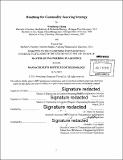| dc.contributor.advisor | Alexis H. Bateman and Shardul Phadnis. | en_US |
| dc.contributor.author | Chong, Wenzheng | en_US |
| dc.contributor.author | Lai, Yuwen | en_US |
| dc.contributor.other | Massachusetts Institute of Technology. Engineering Systems Division. | en_US |
| dc.date.accessioned | 2015-12-03T20:52:07Z | |
| dc.date.available | 2015-12-03T20:52:07Z | |
| dc.date.copyright | 2015 | en_US |
| dc.date.issued | 2015 | en_US |
| dc.identifier.uri | http://hdl.handle.net/1721.1/100079 | |
| dc.description | Thesis: M. Eng. in Logistics, Massachusetts Institute of Technology, Engineering Systems Division, 2015. | en_US |
| dc.description | Cataloged from PDF version of thesis. | en_US |
| dc.description | Includes bibliographical references (pages 70-71). | en_US |
| dc.description.abstract | The procurement and sourcing group of OG company was tasked to systematically forecast, design and develop the future state of the company's next generation supply base. The main objective is to anticipate the preferred locations to source commodities such as machine parts from in the near future. In response to that objective, the purpose of this thesis is to identify the relevant group decision drivers that consist of political, economic, social, technological, environmental, legal and business internal factors that the procurement and sourcing group are evaluating. These drivers were then utilized to develop a tool that is able to quantify, balance and combine the specified drivers so as to determine the overall alignment to the company's procurement and sourcing strategy. This tool also seeks to predict the near-term global competitiveness of oilfield services equipment manufacturing by country. Through on-site interviews, literature review, public data collection and statistical analysis, we were able to identify and specify top drivers that were most relevant to the decisionmaking process of managers in procurement and sourcing group for an oil & gas company. Based on the specified drivers, our analysis identified the top ranked countries using a hierarchical analytical process which was then used to validate the company's current sourcing strategy. Building on this analysis, we propose a framework that determines OG company's next generation supply base. The framework proposed can serve as an organizational development approach and decision-making tool which is useful in uncovering the underlying motivations of the procurement and sourcing managers. The tool also provides qualitative recommendations through a quantitative stepwise approach. The methodology of identifying and quantifying drivers as described in our thesis is especially relevant to industrial manufacturing companies with a global manufacturing footprint. We conclude with the limitations of the framework and potential avenues for future research. | en_US |
| dc.description.statementofresponsibility | by Wenzheng Chong and Yuwen Lai. | en_US |
| dc.format.extent | 153 pages | en_US |
| dc.language.iso | eng | en_US |
| dc.publisher | Massachusetts Institute of Technology | en_US |
| dc.rights | M.I.T. theses are protected by copyright. They may be viewed from this source for any purpose, but reproduction or distribution in any format is prohibited without written permission. See provided URL for inquiries about permission. | en_US |
| dc.rights.uri | http://dspace.mit.edu/handle/1721.1/7582 | en_US |
| dc.subject | Engineering Systems Division. | en_US |
| dc.title | Roadmap for commodity sourcing strategy | en_US |
| dc.type | Thesis | en_US |
| dc.description.degree | M. Eng. in Logistics | en_US |
| dc.contributor.department | Massachusetts Institute of Technology. Engineering Systems Division | |
| dc.identifier.oclc | 928937736 | en_US |
